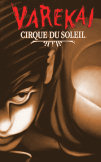Interview by Mary Stevens Decker
Published in the Redmond Reporter May, 2006
 Dr. Ghislaine Robert, formerly of Montreal, practices sports medicine in Redmond and has served Canadian teams at three Olympic games: as a track-and-field coach in Seoul, South Korea, in 1988; and physician in Barcelona, Spain, in 1992, and Sydney, Australia, in 2000. Robert is overseeing the health needs of the Cirque du Soleil’s “Varekai” cast during its engagement at Marymoor Park.
Dr. Ghislaine Robert, formerly of Montreal, practices sports medicine in Redmond and has served Canadian teams at three Olympic games: as a track-and-field coach in Seoul, South Korea, in 1988; and physician in Barcelona, Spain, in 1992, and Sydney, Australia, in 2000. Robert is overseeing the health needs of the Cirque du Soleil’s “Varekai” cast during its engagement at Marymoor Park.
What kind of health issues do you address (while) working with Cirque du Soleil?
Mostly we see overuse injuries, not a lot of traumatic injuries like broken bones. Most of the artists have been national-level gymnasts in their respective countries – we have many from Russia and China in this show – so they are in top physical condition, but can be bothered by tendonitis, shoulder pain, just overusing the muscles. They have a physical therapist and trainer traveling with them, and in every city, they find a massage therapist, an orthopedic surgeon and emergency room in case something unusual happens. It’s my job to coordinate all of that. And like people everywhere, they get colds, flu or bronchitis.
What fitness regimens do they follow?
They do nine shows a week, they rest on Mondays, and when they’re performing, it’s like competing. They’re always training, but there’s actually less pressure than competing – if they make a little mistake, most people don’t notice and they’re not getting points taken away. They eat well. You don’t want to eat two Big Macs before jumping up and down. Besides specific training for their acts, they jog, walk or ride a bike – the normal ways to stay in shape. They’re asked to avoid extreme sports because of the risk of injury.
How old are most of the artists and aren’t they, in terms of what they do in the show, almost “superhuman” in their strength and agility?
Most gymnasts start very young and retire at 17 or 18, then go on to artistic pursuits like Cirque du Soleil. They do a lot of things with hyperextension of the back, or other muscles, so yes, they must have a genetic predisposition or abnormal range of motion.
Like a professional ballet dancer? They either have the right body type or they don’t?
Yes, they must have the body type and also the passion to try this and the motivation to train hard. I also like to point out that I look after the health of the Cirque du Soleil staff, as well as the artists, while they are in town. They, too, work very hard. Setting up, there’s a lot of heavy lifting. You don’t see all the behind-the-scenes action, and coaching that goes into a production like this. It’s very demanding.
Any advice for aspiring Cirque performers from Redmond?
The Cirque has an excellent school in Montreal, which trains athletes and gymnasts from everywhere in the world. Check out the Web site at www.cirquedusoleil.com
— Mary Stevens Decker
